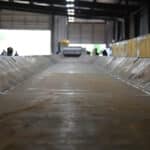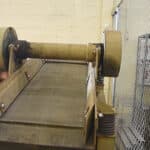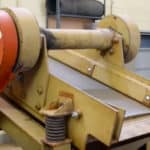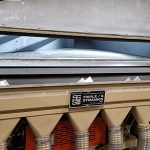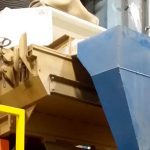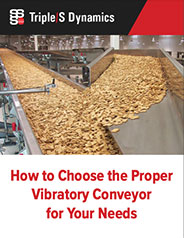Triple/S Dynamics Equipment FAQ
Frequently asked questions regarding Slipstick, Screening, Dry Materials Separation, and General Vibratory Conveying.
Slipstick Vibratory Conveyors FAQ
Can these types of conveyors transport goods at an incline?
While most applications are horizontal, some are required to transport at an incline or a decline. It is possible to move products up very shallow angles using differential motion. The material/object physical characteristics will determine the practical incline. Different product shapes will convey better up inclines than others. Round or spherical product shapes tend to lose the conveying energy through rolling during the end of a product run. Product cleanout of the conveyor pan may also be an issue; however, pan cleaning devices can be introduced to help remove any remaining product pieces in the conveyor pan at the end of the production run. The product travel rate and resulting conveyor capacity will also be lower when conveying products uphill. This lower capacity may be compensated for by increasing the conveyor operating stroke or the pan width.
Can these conveyors be easily cleaned?
With cleaning and sanitation issues being of utmost importance to many processors, this question comes up a lot. The typical horizontal motion conveyor consists of a one-piece formed trough (or pan) section with suspension points spaced periodically along the conveyor pan length. This allows both the interior and exterior surfaces of the conveyor pan to be easily accessed for wipe down cleaning. There are typically no support frames or springs under the conveyor to clean, which introduces cracks and crevices that are very difficult to clean. The gliding of the product along the seamless one-piece formed conveyor pan discourages build-up of materials on the surface. The continuous sliding action on the conveyor’s surface typically scours the pan clean so there’s less time required between production cycles for cleaning.
This type of conveyor can also be totally enclosed in either a rectangular or tubular shape and can be equipped with a CIP (clean-in-place) system. This type of unit employs CIP nozzles located along the length of the conveyor tube so the processor can wet-wash the conveyor interior between product runs.
Can these conveyors handle a head load / full hopper?
Yes. Very large or heavy loads can be discharged this way in a properly designed system. The horizontal motion conveyor has tremendous load carrying ability, with some units able to convey two to three times their own empty weight.
And because it is not a “tuned” system, the horizontal motion conveyor can be operated at variable speeds for control of the material travel rate. These conveyors are not “de-tuned” by typical increases in material loading on the pan of the conveyor.
Will these types of conveyors meter product?
When arranged with a full hopper, the conveyor will vary its discharge rate according to the motor speed. The ability of the differential motion conveyor to convey deep product bed loads allows it to be used as a self-discharging storage unit.
The differential motion conveyor can also be equipped to provide for product aligning, singulating or product de-shingling. A food processor making chocolate covered pretzels had to use several line workers to manually align and de-shingle product downstream from a regular vibratory conveyor that was shingling the pretzels due to the vertical pitching motion. When a horizontal motion conveyor was installed equipped with aligning lanes and special de-shingling ramps, the processor increased productivity and reduced the required manual labor by significantly reducing the number of shingled pretzels that resulted in scrap, therefore increasing line yields and reducing labor costs.
Also, the conveyor pan discharge can be equipped with pneumatically actuated product dams or manually adjustable flow baffles to accumulate and meter product to other downstream equipment. Product degradation is not an issue when using product dams or flow baffles because of the gentle horizontal conveying motion which allows products like snack foods, breakfast cereals or hot dogs to be accumulated up to several feet deep.
Can there be a change in directional flow in this type of conveyor?
A differential motion conveyor can be made to convey in either direction (but only one at a time) when configured correctly. The conveying direction can be reversed by reversing the drive motor’s voltage polarity through the motor’s starter. Reversing product direction can be useful in many applications, such as introducing material onto the differential conveyor’s midsection to be conveyed to a destination at one end of the conveyor and, when the conveying direction is reversed, to a destination at the conveyors opposite end. The differential motion conveyors drive can also be equipped with an optional online reversing mechanism that allows instantaneous product flow reversal for application such as filling bulk off stations.
Can these types of conveyors be totally sealed?
The unique conveying action of this type of conveyor will allow the use of either mated sliding surfaces between conveyors or the use of the standard flexible boot type inlet/outlet connections. A tube type conveyor allows a sealed and separate chamber open to the upstream and downstream process. The conveying section can be a fabricated trough or enclosed tube. If you must isolate your material from your plant environment, whether it is to control dust, provide pressure isolation, blanket the material with an inert gas, or to provide other environmental controls, you can select a totally enclosed tube. One or more feed inlets can be located anywhere along the conveying sections length; each is typically sealed with a flexible boot to control dust. Cleanout ports can also be added along the length of the conveyor.
What if multiple inlets and discharges are required?
More than one inlet and discharge can be incorporated into a single conveyor. The discharges can be a preset ratio of flow, variable discharge amounts or an “all or none” to different discharges. It is also possible to create an inventory of material before each discharge for an immediate delivery during demand.
One or more discharge outlets can be located at any of the various points along the conveying section’s bottom to distribute the material. Each outlet can be fitted with a mechanical discharge gate to start and stop material discharge. These gates, typically pneumatically actuated, can be a sliding style gate, butterfly valve or tip style drop gate.
Multiple inlets can be used to introduce product from different storage devices or to meter in a mixture of materials into one conveyor. This type of conveyor will not stratify or blend these materials to ensure a uniform discharge.
Multiple lanes can also allow different products/materials to be conveyed using the same conveyor pan and a single drive unit. Products will remain separated on the conveyor. In a recent application, several sizes of the same type of products were run in the single conveyor pan.
Will abrasive materials convey on the differential motion conveyor?
By the same nature of gentle handling of fragile products, tough/hard or abrasive materials do not impact or wear the conveyor pan surfaces at high rates. The differential motion of the conveyor does not press the material into the pan, forcing a gouging action that will wear the pan surface faster unlike vibrating conveyors. Abrasive wear is two to four times less than a conventional vibratory conveyor.
Recently, an industrial minerals producer had an application handling abrasive construction sand. Their major concerns were dust control and downtime due to regular vibratory conveyor maintenance because of the abrasiveness of the product. A differential motion conveyor was designed with BHN 400 abrasion resistant conveying troughs, fully enclosed with integral dust covers. This conveyor showed an average surface wear of just 0.010 inches after 14 months of operation. Dust emissions were eliminated and the only maintenance required is periodic lubrication.
In another abrasive application, a ceramic parts producer had a different problem. The dust generated from a cutting process was causing their existing belt conveyor bearings to fail quickly. Access to the bearings which ran the length of the belt conveyor was difficult and cumbersome. When this belt conveyor was replaced with a differential motion conveyor, with the drive unit at one end, moving parts of the unit were not exposed to the dust loading and are now more easily serviced at normal maintenance intervals.
If the conveyed materials are corrosive in nature, like chlorinated bleach powder, a titanium conveying trough may be one solution.
Can moist or sticky products be conveyed on the differential motion conveyor?
If the material to be conveyed is sticky, like dishwashing detergent, a conveying trough made of ultrahigh-molecular-weight polyethylene (UHMW-PE) will prevent sticky particles from adhering to the surface. This type of conveying surface lends itself to reduced product adherence and allows expedition of the cleaning process.
Materials with a high surface tension, like raw meats or cheeses, may be conveyed using textured stainless steel conveyor pan materials.
How large and robust can the conveyors be?
Conveying lengths of over 200 ft and pan widths of 8-10 ft have been in use for many years. Massive impact loads and carrying capacities can be achieved with the use of structural trusses and impact beds. Pan construction of AR plate 1 inch thick and above is commonplace for the harshest conveying environments. Hundreds of these differential motion conveyors are at work today moving scrap steel. One horizontal motion conveyor, weighing in at over 350,000 pounds, 117 feet long, at almost 8 feet wide and 3 feet deep can move over 600,000 pounds per hour of scrap steel.
Water cooled conveyor pans are also used for pre-heating of the scrap metal before being introduced into the melting furnace to reduce the over-all energy requirements.
Are they energy efficient?
In terms of energy consumption, horizontal motion conveyors are very competitive with roller belts, natural frequency and drag type conveyors. They use less than slider belts, and substantially less than screw conveyors. The motor is sized to start the drive, and typically only experiences full load power draw when starting. For most products, the motor runs at 50% or less of rated capacity. The case of deep beds of very heavy conveyed materials, like scrap steel or castings, is the exception, where increasing material loads increase the motor’s amp draw. For most materials, the motor load is independent of the amount of product conveyed.
What about high or low temperatures?
The differential motion conveyor is a highly adaptable piece of equipment suited well for virtually every industry. These conveyors can be operated in a wide range of extreme temperatures.
In certain applications, air or water cooling systems have been used with horizontal motion conveyors to reliably handle materials up to 1700 degrees F.
Can the Slipstick carry out product transfers?
The Slipstick can be designed with several gate options: easy clean, pinch free, pivot, plug, and rail.
How does a horizontal motion vibrating conveyor work without any vertical motion?
In horizontal, zero-pitch conveying, the translation comes from a differential or slower forward movement relative to the retraction, which is quick. The lack of vertical motion provides a much smoother and more gentle handling of the material being conveyed. When the material is not fragile or even hard and abrasive, this same motion reduces the wear on the pan.
Can you do size screening on a horizontal motion conveyor?
Screening is not a good characteristic on a conveyor that does not have any vertical acceleration. With gentle handling also comes reduced little energy to dislodge nearsize pieces that get caught in the openings. Some rough scalping is possible where occasional large oversize pieces are removed from the bulk of much smaller pieces.
Can the Slipstick screen?
No. The gentle, horizontal motion of the Slipstick does not make this conveyor especially suitable for screening fine material out of a product stream. The Slipstick motion does not stratify a product bed by particle size so fines do not readily sift to the bottom of the material bed to come in contact with the screen surface. However, with a bar screen the conveyor can be used to scalp oversize material in some applications.
What is the typical lifespan of a Slipstick?
We have Slipstick conveyors in operation that were manufactured in 1974. Providing the machines are used for their intended purposes and routine inspection is carried out to ensure correct functioning, we believe all our machines should be operational for at least 25 years.
Will the Slipstick operation produce dust?
The Slipstick can be enclosed to ensure a dust tight seal. But the quick forward, slow return settles dust.
Vibrating Screens FAQ
What is scalping?
It is the separation of part of the total feed as course oversize by retention on openings (round, square, or slotted) more than half again as large in diameter or width as the largest particle in the undersize.
What is screening?
Screening means removing part of the total feeds as a fine fraction passing through the screen openings.
What is sizing?
Separating a particulate material into three or more fractions. If two screens are used, the sized fraction passes through the coarser screen and is retained on the finer screen. The oversize and undersize fractions are not sized unless the top size of the former or bottom size of the latter has been limited by previous screening.
Are all vibrating screens alike?
No. The only thing in common for all the various types of vibrating screens is that they move with some kind of regular motion, either reciprocating or circular.
What type of mesh screen is preferred for precision screening?
Square mesh screens maintain their specified opening dimension more accurately than slotted.
What is the best screen for my abrasive product?
Flat-top screens last longer than the standard double-crimp style.
When do I need to use a Grizzly?
Use a Grizzly when width, not length, is the criteria for oversize retention.
What is screen blinding?
When the openings of a screen are closed, either by plastering with damp sticky material or by wedging of on-size particles in the opening.
What is the most effective protection against blinding?
Electric heat.
Dry Material Separation Equipment FAQ
How is fluidizing air and controlled vibration used to separate a dry mixture? Using tuned airflow to stratify the material?
The lighter materials are lifted from the deck surface and allowed to float down the inclination of the deck. Heavier particles are in closer contact with an inclined vibrating surface. This vibration actually moved particles on the surface up the incline, opposite the lighter material not in contact with the vibration.
What is the most efficient way to accomplish separation?
First, you will want to screen the particles into manageable size ranges prior to separation. Where significant variations in shape are found to be detrimental to separation efficiency, size reduction or other process steps to change the shape may be added to reduce the range of variation. Moisture reduction may also be key to effective separation. Some materials absorb moisture and weight, others are complicated by the ‘sticky factor.’
What is the difference between the different models?
In general, there are two different model classifications, rectangular two-way separations and triangular offering a gradient of density out. The rectangular shape is commonly called a stoner. The triangular shape is commonly referred to as a gravity separator or air table.
When should I use a gravity separator?
The triangular shape, or trapezoidal, produces a fan or range of density output allowing one or more intermediate density fractions or “middlings.” In some processes, the middling fraction allows further separation efficiency by allowing other processes. This can be recycled intro further density separation.
When should I use a stoner?
It is used when separation of a smaller amount of dense material from a lighter product. The name is derived from separations of contaminants from agricultural products, but density separations cross into mineral, chemical and many other areas. A stoner may have a higher capacity and lower operator attention requirements, but offer less flexibility and precision.
General Conveying FAQ
I would like to move wood pellets from a bulk bag to a hopper – what would you suggest?
Handling wood pellets from a bulk bag can be approached several different ways. Assuming elevation is needed, a screw, drag, or inclined belt conveyor can work with few restrictions. Bucket elevators may have some application in combination with vibratory feeders/conveyors. Lateral transfer alone could be achieved with vibrating conveyors, although natural frequency tuned versions could have issues with varying head loads. Horizontal motion vibrating conveyors can handle various head load conditions.
What are the advantages of a horizontal motion conveyor vs. a vibratory conveyor?
The horizontal motion conveyor design offers a number of advantages over conventional vibrating conveyors, screw conveyors, and drag conveyors often used in bulk handling applications. Compared to conventional vibrating conveyors, which are usually powered by springs and convey material through the impact on the conveyed material, the horizontal motion conveyor provides gentle transportation. Fragile materials like food products, agglomerated powders, and extruded, flaked, or pelletized products are undamaged and remain intact during the conveying process using the horizontal motion conveyor, the Slipstick.
Our vibratory conveyor tends to break too much of our product and causes some of the coating and seasoning to come off. What can we do?
Consider replacing vibratory conveyors with the Slipstick Horizontal Motion Conveyor. Fragile materials like food products, agglomerated powders, and extruded, flaked, or pelletized products are undamaged and remain intact during the conveying process. The key to horizontal motion conveying is the action of the conveyor upon the inertia of the conveyed materials. During the slow advance of the conveyor’s cycle, material is at a relative rest on the conveying surface. The quick return segment of the cycle gently slides the conveying surface under the material bed. Repeating this cycle 200 – 300 times per minute serves to smoothly convey the material up to forty feet per minute along the length of the conveying surface.
Do the slats need to be tracked on my slat conveyor?
No slat chains do not need to be tracked.
Can I transport raw food on a slat conveyor?
Yes in fact there are very few products that cannot be transported on a slat conveyor. Slats are available in plastic or stainless steel.
Can I accumulate product using a slat conveyor?
Yes there are many different types of material available from very low friction to extremely high grip. Once again it is vital to select the correct slat chain for your product.
Can a slat conveyor be made USDA/3A sanitary standards?
Yes. Most of the slat conveyors we design are food sanitary compliant.
Are slat chain conveyors more expensive than the traditional belts?
Initially they are, but the slat would expect to outlast a traditional belt. It is also easier to clean, easier to replace, you can just replace one link rather than the whole belt and there are no tracking problems.

